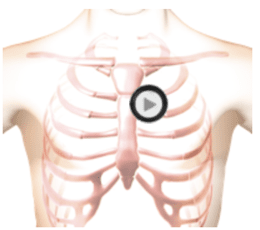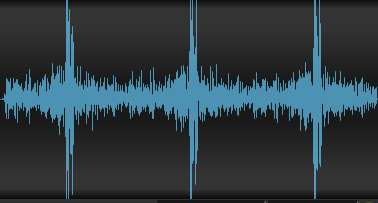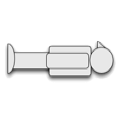This is an example of patent ductus arteriosus heard at the pulmonic position.
Before birth, the two major arteries—the aorta and the pulmonary artery—are connected by a blood vessel called the ductus arteriosus.
Shortly after birth the patent ductus closes and turns into a ligament. However, in certain abnormal circumstances the patent ductus remains open allowing blood to flow from the aorta into the pulmonary artery causing a strain on the right ventricle.
The first heart sound is normal. The second heart sound is obscured by a continuous crescendo-decrescendo murmur which runs from the beginning of systole to the end of diastole peaking at the second heart sound.
In the anatomy video you can see an enlarged left atrium and left ventricle and turbulent blood flow from the aorta to the pulmonary artery through the patent ductus.
Patent Ductus Arteriosus 151 Audio


Patent Ductus Arteriosus 151 Sounds


Half Speed Patent Ductus Arteriosus 151 Sounds


Technique

The patient's position should be supine.
Auscultation Tips for Patent Ductus Arteriosus 151
Systole:Crescendo-decrescendo murmur, peaking late systoleS2:Obscured
Diastole:Crescendo-decrescendo murmur continuing from systole
Sound Wave
Patent Ductus Arteriosus 151 Video
Notice an enlarged left atrium and left ventricle and turbulent blood flow from the aorta to the pulmonary artery through the patent ductus in this cardiac animation.
Authors and Sources
Authors and Reviewers
- ECG heart rhythm modules: Thomas O'Brien.
- ECG monitor simulation developer: Steve Collmann
-
12 Lead Course: Dr. Michael Mazzini, MD.
- Spanish language ECG: Breena R. Taira, MD, MPH
- Medical review: Dr. Jonathan Keroes, MD
- Medical review: Dr. Pedro Azevedo, MD, Cardiology
- Last Update: 11/8/2021
Sources
-
Electrocardiography for Healthcare Professionals, 6th Edition
Kathryn Booth and Thomas O'Brien
ISBN10: 1265013470, ISBN13: 9781265013479
McGraw Hill, 2023 -
Rapid Interpretation of EKG's, Sixth Edition
Dale Dublin
Cover Publishing Company -
EKG Reference Guide
EKG.Academy -
12 Lead EKG for Nurses: Simple Steps to Interpret Rhythms, Arrhythmias, Blocks, Hypertrophy, Infarcts, & Cardiac Drugs
Aaron Reed
Create Space Independent Publishing -
Heart Sounds and Murmurs: A Practical Guide with Audio CD-ROM 3rd Edition
Elsevier-Health Sciences Division
Barbara A. Erickson, PhD, RN, CCRN -
The Virtual Cardiac Patient: A Multimedia Guide to Heart Sounds, Murmurs, EKG
Jonathan Keroes, David Lieberman
Publisher: Lippincott Williams & Wilkin)
ISBN-10: 0781784425; ISBN-13: 978-0781784429 - Project Semilla, UCLA Emergency Medicine, EKG Training Breena R. Taira, MD, MPH
-
ECG Reference Guide
PracticalClinicalSkills.com
Patent Ductus Arteriosus 151 | Auscultation Cheat Sheet with Sounds & Video | #109